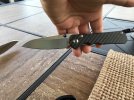- Joined
- Dec 1, 2012
- Messages
- 1,379
I received my new KnifeArt exclusive large Carbon Fiber Insingo Inkosi today. What a simply beautiful knife!
I just wondered if anyone had applied Renaissance wax to a new CRK scale before, the blasted Ti, and what the result was if so. Would you do it again?
I typically wax the blade straight off on a satin finished knife, but never tried CRK Ti to see what the result was.
I’ll post pics tonight when I get home.
I just wondered if anyone had applied Renaissance wax to a new CRK scale before, the blasted Ti, and what the result was if so. Would you do it again?
I typically wax the blade straight off on a satin finished knife, but never tried CRK Ti to see what the result was.
I’ll post pics tonight when I get home.

